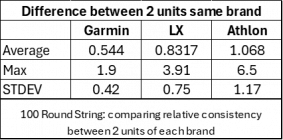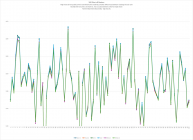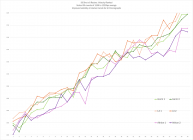V., are you about ready to say that the Athlon chronograph is on par with the Garmin and can serve as an acceptable alternative, at least based on what you’ve determined?
2 responses, which I apologize will largely be non-answers, because ultimately, nah, I wouldn't say I'm ready to make any definitive claims, but also that I'm not necessarily sure what I expect will be "acceptable" for some others - but I do hope to present data and experience which will show folks enough info to make their own educated choices:
1) "About ready..." is relative... I've been rained out - or rained in? - most of this month so I'm FAR behind on finishing the testing I'd like to share. Hoping to get caught up this week in the sun. But today, no.
2) "...to say the Athlon chronograph is on par with the Garmin, and can serve as an acceptable alternative" is also relative. I certainly wouldn't want to speak for all shooters considering these units, but my experience so far, relatively as much and relatively as little as it has been, as been mixed for the Athlon. I have 2+ years with the Garmin, lots of opportunity for proofing, and 8 months with the LabRadar, but only about a month which has mostly been spent watching the rain with the Athlon.
I'm relatively comfortable, at this time in sharing the preliminary experience and experimentation results I completed to improve the design of subsequent experiments, including details of a 100rnd string of terrible 22LR ammo I conducted during my radar interference elimination test - this test wasn't meant for data analysis, so much as meant for determining which units played well together and which don't, but I captured a 100rnd string of 22LR across 6 chronographs, 3 pairs, out of ~200-250 rounds fired that day.
A) Relative offsets appear to persist between brands - applying a heat map for which units read faster vs. slower for each shot, a regular trend appeared:
--> One or both of the LabRadar LX's represented 90 of the fastest shots out of 100, and only ONE out of 100 shots did a LabRadar LX represent the slowest reading for any shot (including ties).
--> One or both of the Athlon untis represented the SLOWEST velocity reading for 89 out of 100 shots, and only represented 10 of the fastest readings (including ties).
--> One or both of the Garmins represented mid-range readings between the other brands 85 out of 100 shots, only representing the fastest shots for 5 out of 100 (including ties), and only represented the slowest readings 10 times out of 100 shots.
So 90% of the time, the LX was faster than the other two brands, and 89% of the time the Athlon was slower than the other two brands. The LX's averaged 0.8fps faster than the Garmins, which averaged 1.2fps faster than the Athlons. The average spread between all 6 units was 3.5fps, with the worst gap between all chronograph readings at 11.1fps, tailing quickly down to 8.2fps for the second largest gap, then 6.4, 6.2, and 6.2fps for the top 5 largest gaps. 80% of shots were less than 4.2fps for all readings.
**Nobody really needs to read all of this, other than to demonstrate the heat map, visually. The Left two columns are the 2 Garmins, middle two columns are the LabRadar LX's, predominantly green, representing the fastest readings for each shot, and the right two columns are the Athlons, predominantly red, representing the slowest readings for each shot.**

B) Within each brand, consistency is very good for all 3 brands, but for THIS test, best in the Garmin. In this 100rnd rimfire test, I saw an average of 0.54fps difference between the 2 Garmin units for each shot, with never more than 1.9fps between the two Garmins. The Average difference between the two LabRadar LX's was 0.83fps, with no more than 3.9fps between the two LX's. The average difference between the two Athlons for 100rnds was 1.07fps, with no more than 6.5fps between the two Athlons for any of the 100 shots. In this particular circumstance, the LabRadar was roughly 50% more variable between two units than were the 2 Garmin units, and the 2 Athlons varied from one another ALMOST twice as much as the Garmins. However, given all of these units have a stated precision of +/-0.1%, which for this ammo would be approximately +/-1.2fps, all 3 brands averaged within the expected precision (Garmin was the only unit which stayed within that window, but all averaged within the expectation). This is simply the consistency between two units of each brand - based on this N=2 test, Garmins may be more consistent in reading from one unit to another than the other two brands.

Less decisively, but similarly to the offset between brands, there was a relatively common offset expected between the two units of each brand. One Garmin displayed faster than the other slightly more than twice as often, and the two only agreed for the same exact reading 9% of the time. The LX's shared a relatively similar ratio - with one unit displaying faster than the other 63% of shots and only slower 37% of the time; however, because the LX's report velocity to the nearest 1/100th rather than 1/10th fps, there were no instances where the LX's agreed exactly on the same speed. The 2 Athlon units agreed on the same speed 21 out of the 100 shots, with one of the units being faster than the other for 47 shots, and only slower for 32 shots - so the Athlons were slightly more even on high/low compared to one another than the other two brands.

D) Unfortunately, but not surprisingly, the ammo I used demonstrated REALLY high variability, which masks the relative trending of the measured velocities for each string. Plotting all 100 shots for all 6 chronographs on a line chart shows one overlapping trend which varies wildly up and down by ~240fps, but with feathered tips at each point where one or the other unit would print 2-3fps faster or slower than the others - but the overall view appears as ONE trendline... So I have to replicate this test with tighter performing ammo, and/or sort a tighter cluster of shot velocities and depict a smaller sub-set of data to show the relative offsets vs. noise ratio between the 6 units. I'm thinking this has to be done with ammo in single digit SD's so the relative offsets are proportionately substantial compared to the population noise. I'm still playing with this 100rnd rimfire data set to see if it can be more presentable by ranking the speeds and culling to a narrower band of 20-30 rounds.
**Note, again, this isn't terribly interesting because the SNR is so low, but you can see overall the units are all trending together, but with slight differences at the peaks and valleys, with relatively few instances of these strings crossing each other.***

E) Frustratingly, all 3 out of 3 Athlon units I have touched have experienced co-channel interference issues. I READILY confirm that LabRadar V1's and LX's, as well as the Caldwell VelociRadar, which are all acoustic or recoil triggered, would hide this interference better than would the Garmin or Athlon which are radar triggered. However, the Garmin is stated to have frequency/channel hopping capabilities to avoid co-channel interference, whereas, it appears the Athlon does not. I HAVE seen co-channel interference with all of these units at this point; velocities of 1800fps for a 1200fps 22LR load or 4100-4700fps for 2800-3100fps loads; but I have not seen the same extent or regularity of occurrence with any other unit other than the Athlon. This interference opportunity ONLY exists when multiple radar units are present, and technically can influence any and all of these commercial ballistic radars. The Athlon just doesn't have frequency/channel hopping capability to run away from interference which the Garmin can do. For someone shooting PRS matches, that MIGHT be an issue as many of us can have radars running on the zero board line at the same time, whereas shooters who rarely find themselves laying shoulder to shoulder with other shooters would need not be concerned. Absent of interfering units and after firmware update, the 2 Athlons I currently have appear to be offering as much truth in reading as the other two brands.
So I'm relatively cautious of interference opportunities with the Athlons, but I'm relatively confident that many shooters could get viable velocities (as I stated I would expect at the outset of this endeavor) from the Athlon at a $75-100 discount below the Garmin.















